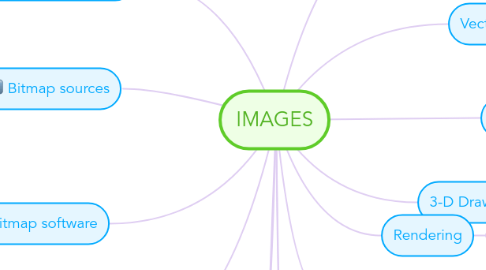
1. Making still images
1.1. -Bitmaps (raster): painting program
1.1.1. -Vector: drawing program
1.2. Bitmaps: can have varying bit & color depths
1.3. Bitmaps suited for creation of photo-realistic images and complex drawing requiring fine detail
1.4. Where do bitmaps come from?
1.4.1. 1. capture a bitmap using camera
1.4.1.1. 2. make a bitmap from scratch with a paint or drawing program
1.4.1.1.1. 3. capture a bitmap from a photo or other artwork
2. Bitmap sources
2.1. 1. Capture using a camera
2.1.1. 2. Make a bitmap from scratch with paint or drawing program
2.1.1.1. 3. Capture a bitmap from a photo or other artwork
2.2. Legal rights protecting use of images from clip art galleries fall into three basic groupings
2.2.1. 1. Public domain: images were never protected by copyright or has ended freely
2.2.1.1. 2. Royalty free- images are purchased and then used without paying addition license fees
2.2.1.1.1. 3. Right-managed: negotiate with the right holder regarding terms for using image & how much you will pay for that use
3. Bitmap software
3.1. 1. Adobe's Photoshop and illustrator
4. Stay in the Know
4.1. Follow our blog to never miss an important update, downtime warning or tutorial!
5. Dithering
6. Window format
6.1. most commonly used imaged file format is DIB or BMP
7. Vector Drawing
7.1. Computer-aided design (CAD) programs needed by architects and engineers
7.2. 3-D animation programs
7.3. Applications requiring drawing of graphic shapes
7.3.1. This is a child idea
7.4. Graphics artists designing for the print media
8. Vector-drawn images
8.1. 1. Vector is a line that is described by the location of two endpoints
8.1.1. 2. Vector drawing makes use of Cartesian coordinates
9. Vector-drawn images versus bitmaps
9.1. 1. Vector images use less memory space & have smaller file size as compared to bitmaps
9.1.1. 2. Vector objects are easily scalable
10. 3-D Drawing
10.1. 1. Modelling- placing all the elements into 3-D space
10.1.1. 2. Extrusion- the shape of a plan surface extends some distance
10.1.1.1. 3. Lathing- a profile of the shape is rotated around a defined axis
11. Rendering
11.1. Use of intricate algorithms to apply user-specified effects
12. Color palettes
12.1. 1. Additive color: created by combining coloured light source in three primary colors-red, green, blue
12.1.1. 2. Subtractive colour: created by combining coloured media such as paints and inks
